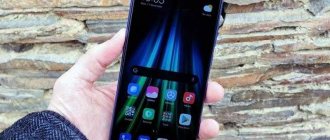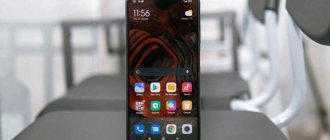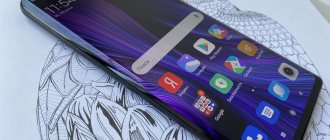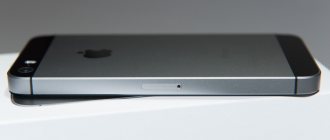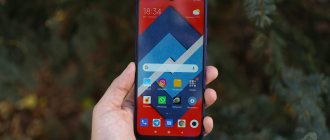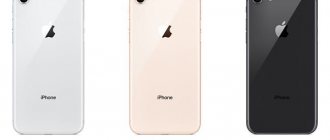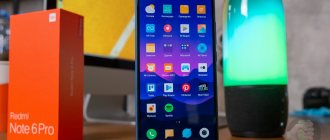Redmi Note 9 firmware
The Redmi Note 9 smartphone is codenamed Merlin. Release date: May 12, 2022. In China it is sold under the name Redmi 10X 4G.
This improved version of the budget smartphone Redmi 9 quickly became popular and earned the love of users. The main feature of the smartphone is the improved camera and increased display diagonal. The RN9's body is made entirely of plastic, but the back panel has a special water-repellent coating that makes it shimmer with all the colors of the rainbow.
The camera block is located on the rear wall, as is the fingerprint scanner. Almost the entire front panel is occupied by a 6.53-inch display. The layout of ports and mechanical keys is standard for entry-level smartphones. The SIM card tray is equipped with a separate slot for microSD memory cards.
The Chinese version, like some global ones, is not equipped with an NFC module. The global model number with NFC is M2003J15SG (code name of this phone is Merlinnfc), other models do not have this module.
- Display 6.53″, 1080 x 2340 px
- Processor MediaTek Helio G85
- RAM 6 GB
- Battery 5020 mAh
- Main camera 48 MP + 8 MP + 2 MP + 2 MP
- Selfie camera 13 MP
- Operating system MIUI 12.5, Android 11
- Test AnTuTu v8 205946
Redmi Note 9 / Redmi 10X 4G models:
Global (M2003J15SS, M2003J15SG): 3 GB 64 GB 4 GB 128 GB China (M2003J15SC): 4 GB 128 GB 6 GB 128 GB India (M2003J15SI): 4 GB 64 GB 4 GB 128 GB 6 GB 128 GB
Performance
The heart of the smartphone is the most powerful eight-core Helio G85 processor from MediaTek, manufactured using the 12 nm process technology. This SoC contains a powerful Mali-G52 MC2 graphics adapter. The smartphone is capable of running modern mobile games without any problems. The GPU frequency is at 950 MHz - this is a very good indicator.
To improve the battery life of Redmi Note 9, LPDDR4X standard RAM modules are installed. This type of memory is most often used in modern smartphones. The amount of preinstalled RAM varies depending on the modification. The top version is equipped with 6 GB of RAM.
The storage built into the phone is UFS 2.1 type. This category includes fast, high-performance and energy-efficient drives. In particular, thanks to this, the phone shows excellent results in synthetic tests. The top version is equipped with 128 GB memory. There is a separate slot for microSD memory cards.
| Chipset | MediaTek Helio G85 |
| CPU | 8 Octa Cores: 2 Cortex A75 2.0 GHz and 6 Cortex A55 1.8 GHz |
| Maximum frequency | 2.0 GHz |
| Architecture | x64 |
| Graphics accelerator | Mali-G52 MC2 950MHz GPU |
| RAM (max) | 6 GB |
| Built-in memory (max) | 128 GB |
| Memory card support | Yes |
Redmi Note 9 test results in AnTuTu v8 Benchmark: 205946
points.
The result is shown for a smartphone model with 6 GB of RAM. See the full AnTuTu rating for Xiaomi smartphones. TOP 5 productive Xiaomi smartphones according to AnTuTu rating:
- 1
Xiaomi 12 Pro1070033 points
- 2
Redmi K50 Gaming1061295 points
- 3
Xiaomi 121027337 points
- 4
Black Shark 4 Pro867578 points
- 5
POCO F3 Pro821847 points
Display
The panel on an IPS matrix has an impressive diagonal of 6.53 inches, which allows you to see even the smallest details on the RN9 screen. FHD+ resolution allows you to get a picture of maximum clarity. Color reproduction is quite good for a budget display. There are only some problems with blacks, which is a problem with the IPS matrix itself.
The brightness of 450 nits is enough to easily view the information on the display even on a sunny day. The matrix is protected by fifth-generation Corning Gorilla Glass, which can withstand drops from a height of up to 1.6 meters.
The protective glass has an oleophobic layer and a high-quality anti-reflective coating that improves the readability of information from the screen.
| Screen resolution | 1080 x 2340 pixels |
| Diagonal | 6.53″ (16.59 cm) |
| Type | IPS LCD |
| Aspect Ratio | 19,5:9 |
| Pixel Density | 395 dots per inch (ppi) |
| Update frequency | 60 Hz |
| Maximum brightness | 450 nits |
| Screen protection | Corning Gorilla Glass 5 |
| Screen to body ratio | 83,5% |
| Color rendition | 16 million colors |
| Frameless screen | Yes |
| HDR support | No |
How to enable NFC on Xiaomi
In order to enable NFS on your Xiaomi, just go to the “Settings” menu item, which is located either on the desktop or on the lowered screen curtain, in the upper right corner in the form of a gear icon.
In earlier versions of Xiaomi you need to find the “Additional Features” section, in the latest models it is called “Connecting and Sharing”. Scroll to the end and you will find the “NFC” section. By switching the switch to the active state, you can configure this function taking into account the manipulations you need and the data you have.
Battery
A capacious 5020 mAh lithium-polymer battery is installed. It ensures trouble-free operation of Redmi Note 9 for 35 hours of talk time. This is an excellent result for a smartphone with similar performance. The battery plays a secondary role here; the energy-efficient components used and the optimized MIUI are much more important.
The smartphone supports Qualcomm Quick Charge and can charge at 18 W. There is also reverse charging, so the phone can be used as a Power Bank. Reverse charging power is 9 W.
| Battery capacity | 5020 mAh |
| Battery type | Lithium polymer (Li-pol) |
| Fast charging | Yes, 18 W |
| Wireless charger | No |
| Reverse charging | Yes, 9 W |
| Full charge time | 150 minutes |
| Talk time | 35 hours |
| Working hours when surfing the Internet | 18 hours |
| Operating time when watching video | 18 hours |
Frame
The frame around the screen, as well as the back panel, are made of plastic. This is a very practical and reliable material. The back panel is covered with a special layer that repels water and shimmers in different colors in the light. The assembly is high quality: there are no backlashes or cracks. The plastic feels high quality and dense.
On the back panel of Redmi Note 9 there is a camera unit and a fingerprint scanner. The entire front panel is occupied by the screen. A USB Type-C connector, a 3.5 mm port, a speaker and a microphone are located at the bottom. On the top there is an additional microphone and an infrared port. All other elements are located predictably; there is nothing unusual in the design of the RN9.
The table below shows the dimensions, weight, water protection and colors of the smartphone case.
| Height | 162.3 mm |
| Width | 77.2 mm |
| Thickness | 8.9 mm |
| Weight | 199 grams |
| Moisture protection | IP53 |
| Material | Frame - plastic, back panel - plastic |
| Case colors | Polar White White Black Black Forest Green Green Midnight Gray Gray |
Xiaomi Redmi Note 9 smartphone box
The smartphone came in a white cardboard box. The device and the company logo were depicted on the front side.
All information about the device is printed on the side: manufacturer, characteristics, disposal method, NFC availability, barcodes.
In addition to the device, the kit includes a USB Type-C cable, a charging block, instructions and a silicone transparent case.
Sensors and technologies
The phone has all the sensors except the Hall sensor (the latter is installed exclusively in flagships). The light sensor does not work entirely correctly due to a bug in the MIUI 12 firmware: the system turns the display brightness to minimum when the light level decreases.
The fingerprint scanner is located in the usual place on the back panel of the Redmi Note 9. It works as quickly as possible and is practically error-free. You can also use the face unlock option. To ensure this function works, only the front camera is used; in the dark, this unlocking does not work well.
| Fingerprint's scanner | Yes, back panel |
| Face recognition | Yes |
| Proximity sensor | Yes |
| Light sensor | Yes |
| Hall Sensor | No |
| Accelerometer | Yes |
| Compass | Yes |
| Gyroscope | Yes |
New Xiaomi:
- Redmi K50 Gaming
February 18, 2022
- Redmi Note 11S
January 26, 2022
- Redmi Note 11 Pro 5G
January 26, 2022
- Xiaomi 11i
January 7, 2022
- Xiaomi 12X
December 28, 2021
Data transfer
Please note that Xiaomi phones with NFC do not support sending/receiving large files, which is explained by the low speeds of the technology. You can send files such as documents, pictures, screenshots. A prerequisite is the presence of the corresponding module on the sending and receiving devices. Then you should check that the option is enabled, then bring the smartphones closer with the back surface of each other and wait for a sound signal. This will complete the data sending process.
Recently, Xiaomi is increasingly equipping mid-price devices with such a chip. This contributes to the fact that contactless payment is increasingly becoming part of our lives, making it more comfortable and safe.
Cameras
The main sensor of the rear camera is Samsung S5KGM1 with 48 megapixels. It has an aperture of ƒ/ 1.79, which is why even at night the pictures are impressive. The remaining lenses are an 8 MP ultra-wide-angle camera (118° viewing angle, f/2.2 aperture), a 2 MP macro camera (autofocus, f/2.4 aperture) and a 2 MP depth sensor (ƒ/2.4 aperture). They are auxiliary and increase the overall quality of the picture.
Fully HDR supported. Artificial intelligence is working on image processing.
The 13 MP RN9 front camera module with a CMOS sensor and an aperture of ƒ/2.25 is responsible for taking selfies. Thanks to artificial intelligence and post-processing, the pictures are quite high quality.
The selfie camera can record video in Full HD at 30 frames per second. There are special filters for improving portraits that work in real time.
| Main camera | 48 MP + 8 MP + 2 MP + 2 MP |
| Front-camera | 13 MP |
| Flash | LED |
| Autofocus | Yes |
| Optical stabilization | No |
| Main camera video | 1080p at 30 fps 720p at 30 fps Slow motion 120 fps |
| Selfie camera video | 1080p at 30 fps 720p at 30 fps |
You can see examples of photos from the cameras of the Redmi Note 9 mobile phone in various conditions on the DXOMARK website when they test them.
Firmware: MIUI 12, but still Android 10
Although the Redmi Note 9T is a new smartphone, it comes with the old Android 10. This can certainly be disappointing, but in reality the version of the “green robot” in Xiaomi smartphones does not play a big role, since the functionality of the MIUI shell is almost identical on all smartphones, regardless from Android version.
MIUI 12 comes with many notable features. For example, people who can't deal with the camera hole in the screen will like the function of masking this cutout - a black stripe appears on the display that merges with the frame around the screen, and only system icons like the time or Wi-Fi connection are displayed on it . It can also be customized by choosing a display style.
The firmware is full of interesting features, and one of them concerns brightness adjustment. You can manually adjust it, but if the lighting gets too bright, the smartphone will force it to increase the manual limit. This option may be useful for those who are dissatisfied with automatic adjustment.
Among all the functions, the game mode stands out, allowing you to set system settings for each game separately. You can adjust the sensor's response or sensitivity to repeated taps, which can help with fast-paced games.
You can also specify an area of the screen that will not respond to touch. But the function of increasing contrast in a specific game (the “Improved visualization” slider) is not available for Redmi Note 9T - perhaps due to the lack of drivers for Dimensity 800U.
The Quick Access Toolbar is always active in Game Mode - an awkward swipe from the top left corner will bring up shortcuts that can launch apps or certain game functions. For example, you can limit notification bubbles, clear memory, take a screenshot, start screen recording, and even enable broadcasting of the picture to the big screen. One of the most useful options is the ability to turn off the screen and leave the game running in the background - this is especially useful for games that require you to be online. And this saves a lot of battery power.
The ability to use floating windows for applications is also one of the advantages of MIUI.
In MIUI 12, everything is thought out - this creates an extremely positive impression. A huge number of offered options that allow you to customize the system for yourself (and especially interface customization) allow you to get maximum satisfaction from your smartphone. It is worth noting that MIUI is one of the most different firmwares from pure Android.
MIUI is a shell that pleases some with its rich functionality, but repels others with its overload. Perhaps the best way to describe it is “bloated” - and not necessarily with a negative connotation. True, we must not forget about advertising on every corner - however, you can turn it off.
Communications
The modem built into the smartphone is capable of working with all 4G frequencies. But some of them are blocked at the software level. The speed when connecting to the mobile Internet is decent. 3G and 2G support available. Signal reception is always stable even in the most remote areas. There are no problems with contactless payments, since NFC is present.
The dual-band Wi-Fi transmitter is capable of simultaneously operating at both 2.4 GHz and 5 GHz frequencies. But you will need a router with the appropriate capabilities. Bluetooth version 5.0 supports a variety of profiles. Including energy saving profile. Current navigation systems are supported. The smartphone quickly searches for satellites and accurately determines the user's location.
| SIM cards | Nano SIM + Nano SIM |
| eSIM support | No |
| Wi-Fi version | Wi-Fi 5 (802.11 a/b/g/n/ac) |
| Wi-Fi Features | Dual Band, Wi-Fi Hotspot, Wi-Fi Direct, Wi-Fi Display |
| Bluetooth version | Bluetooth 5.0 |
| Bluetooth Profiles | LE, HID, A2DP |
| USB type | USB Type-C |
| Navigation | GPS, GLONASS, Beidou, Galileo |
| 5G | No |
| 4G/LTE | Yes, B1 (2100), B2 (1900), B3 (1800), B4 (1700/2100 AWS 1), B5 (850), B7 (2600), B8 (900), B20 (800), B28b (700) , B28a (700), B38 (TDD 2600), B40 (TDD 2300), B41 (TDD 2500) |
| 3G | Yes, B1 (2100), B2 (1900), B4 (1700/2100 AWS AF), B5 (850), B8 (900) |
| 2G | Yes, B2 (1900), B3 (1800), B5 (850), B8 (900) |
| Infrared port | Yes |
| NFC | Yes |
Detailed technical specifications
Make and model
Make and model of the device, and alternative names (if any).
| Brand Device manufacturer company. | Xiaomi |
| Model Device name. | Redmi Note 9 |
| Alternative names Other model names, if available. Sometimes the model is called differently, depending on the country or because of popular nicknames. | Redmi Note9 M2003J15SC |
Design
Appearance of the device including dimensions, weight, volume, colors and materials.
| Width The horizontal side of the device when used in standard orientation. | 77.2 mm (millimeters) |
| Height The vertical side of the device when used in standard orientation. | 162.3 mm (millimeters) |
| Thickness The cross-sectional size of the device. | 8.9 mm (millimeters) |
| Weight How much does the device weigh excluding the case, SIM and memory cards and other additional elements. | 198 g (grams) |
| Volume Approximate value calculated using the formula: length times width times height. | 111.51 cm³ (cubic centimeters) |
| Colors What colors is the device available in? | Blue Black White Pink Red Green |
| Housing materials What materials is the body made of? | Glass Plastic |
Central processing unit (CPU)
| Processor size Processor capacity is a parameter that indicates how many bits of data a processor register processes in 1 clock cycle. This is usually 32 or 64 bits. | 64 bit |
| Instruction Set Architecture Instruction set architecture (ISA) is a programmable part of the microprocessor core used by software to control the operation of the processor. | ARMv8.2-A |
| Number of processor cores The processor can be either single-core or multi-core. The performance of the processor depends on the number of cores (threads). The more cores working simultaneously, the higher the power consumption, so in mobile devices all cores are used only under high load. | 8 |
| CPU clock speed Clock speed is the number of operations per second that a processor or its core can achieve. The higher the frequency, the higher the overall performance of the device, but performance also depends on the processor architecture and the number of cores. | 2000 MHz (megahertz) |
Random access memory (RAM)
| Amount of random access memory (RAM) RAM (Random Access Memory, RAM, RAM) is temporary memory (works only while the device is running), which stores data and code for the operational operation of programs and applications. The more RAM, the more programs you can run simultaneously without loss of performance (there will be fewer “brakes”). | 4 GB (gigabytes) 6 GB (gigabytes) |
| Type of random access memory (RAM) Information about the type of RAM used by the device. | LPDDR4X |
| Number of RAM channels 1 is a single-channel RAM operating mode, basic, when 1 memory module is used. 2 is already a two-channel mode - a mode of parallel operation of 2 modules or pairs of modules, memory channels - this mode is 2 times faster than a single-channel one. 3 – three-channel mode is 3 times faster than single-channel mode. | Dual channel |
| RAM frequency The frequency of RAM determines the speed of RAM, or rather the speed of data transfer and reception. In theory, the higher the frequency, the more powerful the RAM. | 2133 MHz (megahertz) |
Built-in memory
Most mobile devices have built-in Flash memory, which is used as a storage for system data, the operating system, as well as user data - photos, videos, recordings and much more.
| Built-in memory capacity The higher the amount of built-in memory, the more games, programs, music, videos and your other files will fit in the device, especially the amount of memory is important when the device does not support memory cards. | 64 GB (gigabytes) 128 GB (gigabytes) —- UFS 2.1 |
Operating system
A mobile operating system (OS) is pre-installed software with a well-thought-out interface for user control of device functions.
| Operating system (OS) The operating system installed by default by the device manufacturer, as well as its version. | MIUI V11 (Android 10) |
Battery
To operate autonomously, a mobile device requires a battery that powers all its components.
| Battery capacity The main characteristic of a battery is its maximum capacity, that is, the charge it can store. Capacity is measured in mAh (mAh, milliamp-hour). The higher the capacity, the longer the mobile device can work. | 5020 mAh (milliamp-hours) |
| Battery type Many types of batteries have been used in portable devices, but NiCd (nickel-cadmium), NiMH (nickel-metal hydride), and even more so SLA (lead-acid) batteries are already considered obsolete. Instead, modern mobile devices use Li-Ion (lithium-ion) and Li-Pol, Li-Poly (lithium-polymer) batteries. | Li-Ion (Lithium-ion) |
| Power adapter Characteristics of the charger (adapter, power supply) included in the standard package of the mobile device. More precisely, the output voltage in volts (V) and the output current in amperes (A). | 5 V (volts) / 3 A (amps) 9 V (volts) / 2 A (amps) 12 V (volts) / 1.5 A (amps) |
| Fast charging Fast charging is when the device charges very quickly. For example, up to 50-70% of a full battery charge in ten minutes. | Yes |
Screen
The screen (display) is the main element for displaying graphic information.
| Technology The technology used to make the screen. There are many types of display manufacturing with their pros and cons. | IPS |
| Diagonal The screen diagonal of a device is measured in inches (inch, in or simply ″), and 1″ is equal to 2.54 cm. | 6.53 in (inches) 165.86 mm (millimeters) 16.59 cm (centimeters) |
| Width Approximate screen width | 69.51 mm (millimeters) 6.95 cm (centimeters) |
| Height Approximate screen height | 150.6 mm (millimeters) 15.06 cm (centimeters) |
| Aspect Ratio Aspect ratio is the ratio of the shorter side of the screen, which is considered to be 1, to the longer side, which is denoted by a decimal fraction indicating the ratio to the short side. | 2.167:1 |
| Screen resolution Screen resolution is the number of horizontal pixels (dots) multiplied by the number of vertical pixels. The higher the resolution, the more detailed the image will be. | 1080 x 2340 pixels |
| Pixel Density The number of pixels per inch or PPI (pixels per inch) indicates the density of pixels per 1 inch (2.54 cm) of the screen. The higher the PPI, the sharper the image, and the less visible or even invisible “squares and dots” (pixels). | 395 ppi (pixels per inch) 155 ppcm (pixels per centimeter) |
| Color depth Color depth means how many bits are used in 1 pixel to display color (bits per pixel). | 24 bit 16777216 colors |
| Screen area Approximate usable area occupied by the screen on the front of the device. The higher the percentage, the narrower the frames around the display or the smaller the “chin with bangs.” | 83.81% (percent) |
| Touch screen A touch screen is a device that usually covers the display and is a touch input tool. In fact, in mobile devices, the touchscreen is a replacement for the keyboard and mouse. | Yes |
| Touch screen type There are many types of touch screens, with their pros and cons. Mobile devices often use capacitive touchscreens, but technology does not stand still and new types of sensors are appearing. | Capacitive |
| Impact-resistant protective glass of the display The screen and touchscreen of a mobile device are usually covered with protective tempered glass (sometimes plastic or film is used instead of glass) to protect the display from impacts and scratches. Many companies are engaged in the production of such protection, but the most famous are Corning - Gorilla Glass and Asahi - Dragontrail. | Yes Corning Gorilla Glass 5 |
| 2.5D screen 2.5D is a display with rounded edges. Device manufacturers use a 2.5D screen as a design element, for a pleasant tactile sensation, or to add durability, dust and moisture protection. | Yes |
Main camera
The main camera, usually built into the rear of the device, is designed for creating photo and video content.
| Photomatrix model An image sensor (matrix) is a light-sensitive sensor that converts an optical image into electrical signals that the device can subsequently process. | Samsung S5KGM2 |
| Maximum image resolution This is the maximum number of pixels (dots) horizontally and vertically. The higher the resolution, the more detailed the image will be. Resolution can also be indicated in megapixels - this is the total number of pixels that can be in the image, calculated by the formula: vertical pixels multiplied by the number of horizontal pixels and divide the resulting amount by 1 million. | 8000 x 6000 pixels 48 MP (megapixels) |
| Matrix type There are two main types of photomatrix, CCD (Charge-Coupled Device) and CMOS (Complimentary Metal-Oxide Semiconductor). Mobile devices mainly use a CMOS matrix - it requires less space, has low power consumption and heating. Recently, new types of sensors have begun to appear, for example PureCel from OmniVision. | CMOS (complementary metal-oxide semiconductor) |
| Matrix size The larger the physical dimensions of the sensor, the larger pixels can be installed there or the greater their number, increasing the luminous flux and exposure. That is, the larger the size, the better. | 1/2.25″ |
| Matrix pixel size Pixel size is one of the matrix parameters that determines what size pixels are used in the matrix. The larger the size, the better - less noise and a larger light-sensitive area. | 0.8 µm (micrometers) 0.000800 mm (millimeters) |
| Diaphragm Aperture (f-number, f) is used to control the light flux passing through the lens. The aperture is indicated by a fraction, and the smaller the fractional number, the higher the aperture passing through the lens. The more light that passes through the lens, the better overall, less noise in your photos and better night photography. | f/1.79 |
| Flash type Most mobile devices are equipped with light-emitting diode (LED) flashes, but there are also xenon flashes. As a flash, xenon is better - it is more powerful, but LED is more versatile (can work as a flashlight) and consumes less electricity. | LED |
| Number of lenses in the lens This is the number of optical elements (lenses) that are contained in the optical circuit of a camera lens. | 6 |
| Maximum video resolution This is the maximum number of pixels (dots) horizontally and vertically. The higher the resolution, the more detailed the image will be. | 3840 x 2160 pixels 8.29 MP (megapixels) |
| FPS video recording at maximum resolution FPS (Frames per Second, frame rate) is the number of frames that changes in 1 second. The higher the number of frames per second, the smoother the image will be. In this case, we mean the number of frames that the camera can achieve at its maximum resolution; the lower the resolution, the higher the FPS can be. | 30 fps (frames per second) |
| Presence of flash Incorporating a flash into a mobile device allows you to take pictures in low light conditions. Creates the necessary lighting and compensates for the lack of natural light. | Yes |
| Digital zoom With digital zoom (zoom, enlargement), the subject is brought closer due to software image algorithms. The higher the magnification with digital zoom, the worse the image quality (noise, blur) will be compared to a non-zoomed one. | Yes |
| Focus on face Function of auto-detection of living objects and autofocus on their face or head. | Yes |
| Panoramic shooting mode Panoramic photography is a series of frames where each subsequent frame is a continuation of the previous one; at the end of the shooting, all frames are stitched together at the software level to create a panoramic photograph. Frames can be shot both vertically and horizontally, and their width can be up to 360 degrees. This type of shooting is used when the camera's viewing angle is not enough to capture the entire scene. | Yes |
| HDR shooting mode HDR photography takes a quick series of shots with highlights, midtones, and shadows, then combines them into a single frame with high dynamic range. | Yes |
| Electronic (digital) image stabilizer EIS (Electronic Image Stabilizer - digital image stabilization) is performed using software algorithms and is needed to reduce blurring when the camera shakes. | Yes |
| White balance White balance is a setting that helps ensure the correct color reproduction in an image by determining the color temperature of the light source in the frame. The balance can be set either automatically or manually. | Yes |
| ISO Setting ISO is the level of light sensitivity. The lower the ISO, the less sensitive the camera's light sensor and the smoother the image with less noise. The higher the ISO, the higher the light sensitivity, but more noise, graininess, or decreased sharpness. | Yes |
| Additional Information Additional information about the functions and characteristics of cameras. | Autofocus Geo-tagging Touch focus Exposure compensation Self-timer Scene selection mode Macro mode Phase detection autofocus (PDAF) |
Additional cameras
Secondary cameras allow you to expand the capabilities of the main camera, such as adding a wide shooting angle, sharpness, optical zoom and other functions depending on the type of secondary camera.
| Second additional camera | 8 MP (megapixels) OmniVision OV8856 f/2.2 (aperture) 119° (viewing angle) |
| Third additional camera | 2 MP (megapixels) GalaxyCore GC02M1 f/2.4 aperture |
Front-camera
The front camera of a mobile device (selfie camera, rear camera) is a camera on the front part, which is usually used for video communication, recognition of gestures or faces, and selfie photographs.
| Photo resolution The maximum image resolution that the camera can produce. As resolution increases, image detail increases. Resolution can also be indicated in megapixels (the total number of pixels that an image can consist of) - these are vertical pixels multiplied by horizontal pixels and divided by 1 million. | 4160 x 3120 pixels 12.98 MP (megapixels) |
| Diaphragm An aperture (or aperture) is essentially an adjustable baffle to control the amount of light passing through the lens. The aperture is indicated by a fraction, and the smaller it is, the more light passes through the lens, which has a positive effect on photographs - there will be less noise and better night photography. While the main cameras also come with an adjustable aperture, most front cameras have a fixed aperture. | f/2 |
| Video resolution This is the maximum resolution the camera can record video at. The higher the resolution, the better. | 1920 x 1080 pixels 2.07 MP (megapixels) |
| Frame rate (FPS) of video shooting This is talking about FPS at maximum video resolution; at lower resolutions, the frame rate per second can be higher. FPS determines the smoothness of the video, as well as the ability to speed up or slow down it. | 30 fps (frames per second) |
| Face unlock This is a new way to unlock your phone using facial recognition | Yes |
| Additional Information Additional information about the functions and characteristics of cameras. | HDR shooting Face recognition |
Memory card
A memory card (flash card) is an external data storage device that is used in many devices to increase memory capacity.
| Memory card type and formats Mobile devices usually use 3 types of memory cards - SD, miniSD and the most common microSD. Each type has its own formats that the device supports. | microSD microSDHC microSDXC |
SIM card
Subscriber Identification Module (SIM) used in mobile devices to identify subscribers in cellular networks.
| Type, size of SIM card A regular (mini SIM) card has dimensions of 25x15 mm. Micro SIM - 15x12 mm. Nano SIM - 12.3x8.8 mm. The sizes of SIM cards are different and not interchangeable. There is also an eSIM (virtual, electronic SIM card), it is built into the device and does not take up space. | Nano-SIM (4FF - fourth form factor, since 2012, 12.30 x 8.80 x 0.67 mm) |
| Number of SIM cards How many SIM cards does the device support? | 2 |
| Additionally Additional information about the operation of SIM cards in the device. | Dual SIM stand-by (Both cards are active. When one is busy talking, the other is deactivated.) |
Mobile networks
This is a system in which communication and data transfer is carried out between subscribers, the location of one or more of which changes. This section lists the supported mobile communication standards and frequencies.
| GSM GSM (Global System for Mobile Communications) is a standard for digital mobile cellular communications of the second generation 2G with time and frequency division of channels. GSM came to replace analog cellular communications 1G (first generation). | GSM 850 MHz (B5) GSM 900 MHz (B8) GSM 1800 MHz (B3) GSM 1900 MHz (B2) |
| CDMA CDMA (Code Division Multiple Access) - this mobile communication standard can be classified as a 2.5G network (generation), unlike 2G, CDMA has higher speech quality, higher cellular network capacity and increased data transfer speed. | CDMA 800 MHz (BC0) |
| LTE LTE (Long-Term Evolution, often referred to as 4G LTE) is a standard for wireless high-speed data transmission, which, although it belongs to fourth generation networks (4G), is essentially a transitional stage from 3G to 4G, greatly accelerating data transfer speeds. The standard has an improved version, LTE Advanced (LTE-A), which can already be considered a full-fledged 4th generation network. | LTE-FDD 850 MHz (B5) LTE-FDD 900 MHz (B8) LTE-FDD 1800 MHz (B3) LTE-FDD 2100 MHz (B1) LTE-FDD 2600 MHz (B7) LTE-TDD 2300 MHz (B40) LTE- TDD 2500 MHz (B41) |
| WCDMA WCDMA (W-CDMA, Wideband Code Division Multiple Access) is a third generation mobile communication standard (3G), which is an add-on to GSM and provides high-speed Internet access. | W-CDMA 850 MHz (B5) W-CDMA 900 MHz (B8) W-CDMA 1900 MHz (B2) W-CDMA 2100 MHz (B1) |
Mobile network data standards
What data transfer standards in cellular networks are supported by the device, as well as their speed.
| Data transmission technologies Technologies for receiving and transmitting data, as well as their maximum speed. | UMTS (384 kbit/s) EDGE GPRS HSPA+ LTE Cat 12 (102.0 Mbit/s, 603.0 Mbit/s) EV-DO Rev. A (1.8 Mbit/s, 3.1 Mbit/s) TD-SCDMA TD-HSDPA |
WiFi
Wi-Fi (Wireless Fidelity) is a technology for wireless data transmission over a local network among devices based on IEEE 802.11 standards.
| Wi-Fi Direct support The Wi-Fi Direct protocol allows multiple devices to connect directly, bypassing the use of routers or access points. | Yes |
| Wi-Fi Hot-Spot A hotspot is a Wi-Fi access point. In a mobile device, Hot-Spot turns the smartphone into a Wi-Fi access point, essentially turning it into a router capable of distributing the Internet. | Yes |
| Dual-band Wi-Fi DUAL-BAND (dual-band) Wi-Fi is the ability of a device to immediately receive or broadcast wireless signals in two frequency bands 2.4 and 5 GHz. 5GHz is a less congested frequency, due to which the connection will be of better quality. | Yes |
| WiFi Supported WIFI wireless network standards. | 802.11a (IEEE 802.11a-1999) 802.11b (IEEE 802.11b-1999) 802.11g (IEEE 802.11g-2003) 802.11n (IEEE 802.11n-2009) 802.11n 5GHz 802.11ac (IEEE 802.11ac) Wi-Fi Display |
Bluetooth
Bluetooth (BT, bluetooth (z), “blue tooth”) is a short-range wireless network (up to 10, sometimes 100 meters) operating on radio waves to transmit voice and data between devices.
| Bluetooth version Bluetooth technology is actively developing and, since 1998, has been constantly updating versions of the standard. Each subsequent version introduces one or several improvements in data exchange speed, range, facilitates pairing, reduces power consumption, or introduces some new protocols and operating profiles. The higher the Bluetooth version, the better. The technology is also backward compatible, for example, if your mobile device has version 5.0, then it will work with accessories version 4.2 and lower, but the improvements introduced in version 5.0 will not work; they will work only if both the device and accessories are version 5. | 5.0 |
| Bluetooth Low Energy (BLE) Bluetooth LE is a low energy BT protocol specification. | Yes |
| A2DP profile The A2DP Bluetooth profile is designed to transmit a high-quality two-channel stereo signal via Bluetooth to wireless headphones, speakers and other acoustics. | Yes |
Sensors
Modern devices have many sensors that help in measurements, trigger functions, and make using the device more pleasant.
| Light sensor The light sensor reacts to the light level and is able to adjust the screen brightness automatically based on this. This is necessary to reduce power consumption and ease of use of the device. | Yes |
| Proximity sensor The proximity sensor reacts to the proximity of the mobile device to some object. For example, the sensor is used when talking on the phone to turn off the screen, which saves energy and prevents you from pressing buttons with your ear or cheek. | Yes |
| Gyroscope Gyroscope (gyroscope, gyro sensor) is a sensor for orientation in space that tracks the angle of inclination of even a stationary device along three coordinate axes. The sensor is mainly used in conjunction with an accelerometer in games and applications. | Yes |
| Accelerometer An accelerometer is a sensor that measures apparent acceleration, that is, it determines the position and distance at which a mobile device moves in space. Based on the data from this sensor, the screen orientation change, pedometer, control using tilts and gestures in games and applications, etc. work. | Yes |
| Fingerprint's scanner The scanner is responsible for authorization using a previously saved fingerprint, as a result of which the device is unlocked, payment is made, some action is confirmed - just put your finger on the scanner. Scanners can be either built into the body or built into a button or screen. | Yes |
| Digital compass This is software that displays data from a magnetic sensor or GPS in the form of a compass on the screen of a mobile device. If there are no sensors or GPS, then the digital compass will not work. | Yes |
| Additional sensors |
Audio
Audio - characteristics and capabilities of a mobile device in terms of sound.
| Music speaker There are two types of speakers in mobile devices - auditory and musical. The auditory speaker (speaker) is used for conversation, the music speaker (buzzer) is used to play music and sounds. | Loudspeaker Earphone —- Smart PA Dual microphones with active noise cancellation |
Radio
The radio in a mobile device can be built-in by the manufacturer (catch local radio channels, no internet required, often works only with headphones (as an antenna), but not always) or installed as an online application (requires internet, but more channels and often better quality) .
| Built-in radio Is a radio tuner integrated into the mobile device? | Yes |
Navigation and location
The location is determined by satellite navigation systems that track the device's autonomous geospatial location at multiple points. The most common satellite navigation systems are GPS, GLONASS, and the Chinese BeiDou.
| GPS GPS (Global Positioning System) is a global satellite navigation system that can determine the position of a mobile device, build routes and find the desired object on the map with an accuracy of several meters. | Yes |
| A-GPS A-GPS (Assisted GPS) is an assistive technology that will help you quickly find the location of your cellular device without waiting for satellite data, which is especially important in indoors and cities. Location is determined in various ways, for example, Wi-Fi access points, mobile towers, bluetooth and others. | Yes |
| GLONASS GLONASS is a Russian Global Navigation Satellite System, which is similar to GPS and works in tandem with it, increasing the accuracy and speed of navigation. | Yes |
| Additional navigation systems | Galileo Beidou NavIC |
USB connector
USB (Universal Serial Bus) is a serial interface for connecting peripherals to computers, smartphones, laptops and much more. The interface allows you to exchange data and power a peripheral device with energy, as well as connect several peripheral devices to one USB connector at once.
| Connector type What type of USB connector is used in the device. | USB Type-C |
| USB standard The higher the standard, the faster the throughput, or more precisely the data exchange rate. With version 3.0 of the standard, the current was increased to 0.9A, eliminating the need for additional power for some devices. | 2.0 |
| USB Mass Storage Connecting a mobile device via USB as a data storage device. That is, when you enable this mode, your device can be used as a flash drive. | Yes |
| USB OTG support OTG is the ability to connect peripherals, such as keyboards and mice, flash drives, card readers, and much more, to the USB port of your device via an adapter or directly. You can connect devices that do not require specialized drivers or additional power. | Yes |
| Additional characteristics Additional features of the USB connector, for example, OTG, whether the connection is supported, peripheral devices and additional memory. | Charging via USB |
Headphone jack
A TRS headphone jack (or jack) is a common standard of connectors used for transmitting audio signals. By diameter there are jack (6.5 mm), mini-jack (3.5 mm) and micro-jack (2.5 mm). In mobile devices, the 3.5mm jack was considered the most popular and widespread, but recently they began to be removed, leaving only USB connectors, through which headphones are connected with a corresponding plug or using adapters.
| 3.5mm headphone jack Does the device have a 3.5 mm audio jack? | Yes |
Connection and synchronization
Options for synchronizing your mobile device and connecting it to other devices.
| NFC NFC (Near field communication, near contactless communication) is a technology for contactless communication between devices over a short distance. Widely used for contactless payment, in the form of a travel card or pass, and is also used for reading and interacting with NFC tags and for exchanging data between devices. | Yes |
| Infrared port Previously, infrared port (IrDA, IR port) was used to exchange data between devices. Now the IR port is used in mobile devices as a universal remote control for TVs, air conditioners and other equipment controlled by an infrared system. | Yes |
| Connection, synchronization Types of synchronization and connection technologies supported by the device. | Computer sync OTA sync Tethering VoLTE ViLTE VoWiFi |
Browser
A browser is a browser program for viewing sites and their content on the Internet. Through the browser, you can open websites, search for information, download necessary files, watch streaming videos, play browser games, etc.
| Technologies Markup and programming languages supported by the built-in (standard) browser. For mobile devices, you can install additional browser applications if the standard one does not suit you. | HTML HTML5 CSS 3 |
Audio file formats/codecs
Mobile devices support many audio file formats, as well as codecs for playing them.
| Default formats The formats that the mobile device supports out of the box are indicated. But if the device does not support the format you need, then you can try adding support for it. Sometimes support depends on the technical characteristics of the device (“hardware”) and nothing can be added here, but often the ability to process a particular audio format depends on the software part. You can install another audio player or codec set separately. | AAC (Advanced Audio Coding) AAC+ / aacPlus / HE-AAC v1 AMR / AMR-NB / GSM-AMR (Adaptive Multi-Rate, .amr, .3ga) AMR-WB (Adaptive Multi-Rate Wideband, .awb) aptX / apt-X aptX HD / apt-X HD / aptX Lossless eAAC+ / aacPlus v2 / HE-AAC v2 FLAC (Free Lossless Audio Codec, .flac) MIDI MP3 (MPEG-2 Audio Layer II, .mp3) OGG (.ogg, .ogv, .oga, .ogx, .spx, .opus) WMA (Windows Media Audio, .wma) WAV (Waveform Audio File Format, .wav, .wave) LDAC |
Video file formats/codecs
Video file formats that the device supports and is capable of decoding and playing.
| Default formats Video file formats that the device is capable of playing with standard firmware and a standard (built-in) set of programs. Not all formats are supported by default, but you can install a third-party video player and/or set of codecs. | 3GPP (3rd Generation Partnership Project, .3gp) AVI (Audio Video Interleaved, .avi) DivX (.avi, .divx, .mkv) H.263 H.264 / MPEG-4 Part 10 / AVC video H.265 / MPEG -H Part 2 / HEVC MKV (Matroska Multimedia Container, .mkv .mk3d .mka .mks) MP4 (MPEG-4 Part 14, .mp4, .m4a, .m4p, .m4b, .m4r, .m4v) VC-1 Xvid |
Sound and multimedia
Redmi Note 9 has only one mono speaker, but this does not affect the volume of sound playback. The volume reserve is enough even to hear a bell on the subway. There are also no questions about the quality of sound reproduction through the speaker: the sound is clear and crisp. The built-in one is quite suitable for watching videos.
The 3.5 mm jack allows you to connect wired headphones to your phone and enjoy excellent sound. Digital FM radio is also available. The smartphone out of the box is capable of playing many audio and video formats, but it is better to use a third-party player (like PowerAMP).
| Speakers | Mono |
| 3.5 mm jack | Yes |
| FM radio | Yes |
| Dolby Atmos | No |
| Sound formats | MP3, FLAC, WAV, M4A, APE, AAC, OGG Vorbis, AMR |
| Video formats | MP4, MKV, AVI, 3GP, WEBM, ASF |
